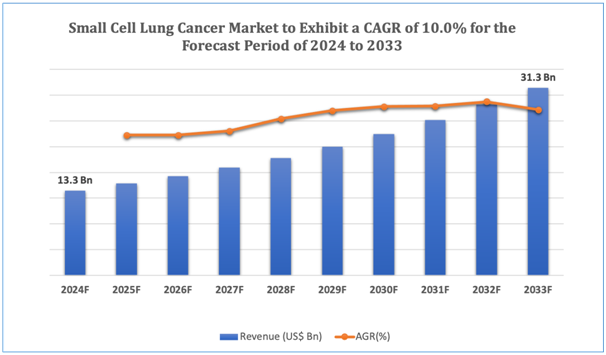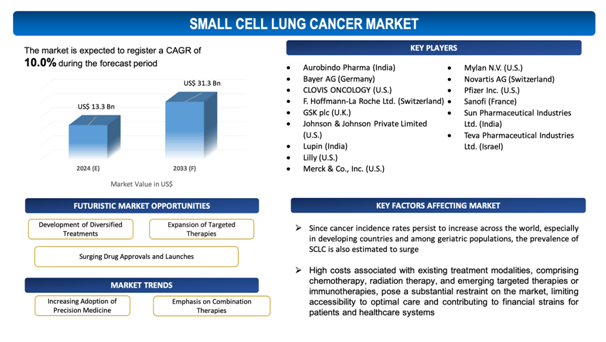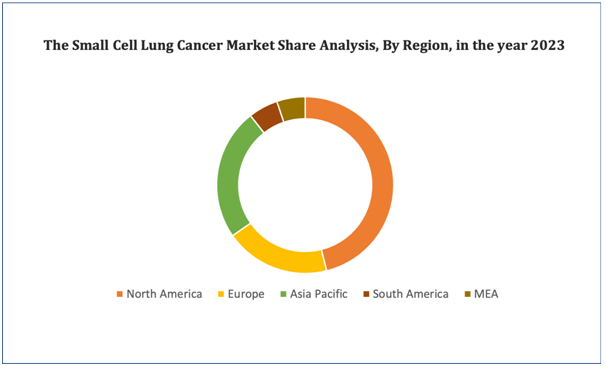Small Cell Lung Cancer Market Overview
The global Small Cell Lung Cancer market is estimated to be worth over USD 31.3 Bn in 2033 and is expected to grow at CAGR of 10.0% during the forecast period (2024-2033).
Small cell lung cancer (SCLC) poses as a distinct and hostilesubset of lung cancer, marked by its swift growth, high metastatic potential, and robust association with tobacco smoking. Accounting for approximately 10-15% of all lung cancer incidences, SCLC is infamous for its tendency to spread early to remote sites, resulting in a poor prognosis and limited treatment alternatives. Histologically, SCLC is marked by tiny, round cells with scant cytoplasm and greater nuclear-to-cytoplasmic ratios. Whilst the exact etiology of SCLC remains multivariable, comprising genetic predisposition, tobacco smoke exposure, and environmental factors, smoking cessation remains the most efficient strategy for prevention. The global market for SCLC embodies a scale of diagnostic, therapeutic, and supportive care interventions focused at enhancing patient outcomes and quality of life.
Significant developments in the market involveinnovations in diagnostic techniques such as imaging modalities and biomarker testing, allowing earlier detection and accurate staging of SCLC. Treatment alternatives for SCLC generallyinclude a confluence of chemotherapy and radiation therapy, with surgery reserved for early-stage disease. However, despite initial responses to treatment, the majority of patients with SCLC witness disease recurrence and eventual resistance to therapy, underscoring the pressing need for novel treatment approaches. Emerging trends in the SCLC market comprise the development of targeted therapies and immunotherapies, leveraging insights into the molecular and immunological characteristics of SCLC to recognize new therapeutic targets and improve treatment efficiency. In addition, the consolidation of precision medicine approaches and biomarker-driven therapies holds commitment for optimizing treatment outcomes and personalizing care for patients with SCLC. Overall, while the prognosis for patients with SCLC remains challenging, continuing research and innovation in the field offer promise for enhanced survival rates and better quality of life for individuals affected by this aggressive form of lung cancer.
Figure 1. Small Cell Lung Cancer: Market Size

Get more details on this report - Request Free Sample
Key Market Insights &Current Market Landscape:
The global small cell lung cancer (SCLC) market is marked by key insights into the disease's belligerent nature, limited treatment alternatives, and the pressing need for novel therapeutic approaches. Substantial developments in the market comprise advancements in diagnostic techniques such as molecular profiling and liquid biopsies, facilitating more precise diagnosis and personalized treatment selection on the basis of individual tumor characteristics. In addition to that, the emergence of targeted therapies and immunotherapies presents a substantial shift in the treatment outlook, with continuing research emphasized on determining new therapeutic targets and overcoming resistance mechanisms in SCLC. Novel technologies presented in the market comprise next-generation sequencing platforms, immune checkpoint inhibitors, and antibody-drug conjugates, providing new avenues for enhancing treatment efficiency and patient outcomes. Regardless of these advancements, challenges persist in SCLC management, including the development of drug resistance, limited options for recurrent disease, and the necessity for better predictive biomarkers. However, with sustained research and investment in innovative therapies and precision medicine approaches, the global SCLC market holds commitment for enhanced treatment alternatives and improved outcomes for patients affected by this hostile form of lung cancer.
Market Dynamics
Market Drivers
Rising Incidence of Cancer Worldwide
Since cancer incidence rates persist to increaseacross the world, especially in developing countries and among geriatric populations, the prevalence of SCLC is also estimated to surge. As per the reports of the World Cancer Research Fund International, Lung cancer is the second most common cancer across the world. It is the most common cancer in men and the second most common cancer in women.There were more than 2.2 million new cases of lung cancer in 2020.Factors contributing to this trend comprisecontinuous tobacco use, environmental exposures, and aging demographics. With SCLC accounting for a considerable portion of lung cancer cases, the soaring burden of lung cancer contributes to the overall expansion of the SCLC market. Alongside, innovations in cancer screening and diagnostic technologies have paved its way to enhanced detection rates, leading to earlier diagnosis of SCLC cases. This earlier detection not only boosts the pool of patients requiring treatment but also enables for timely intervention, potentially enhancing patient outcomes. As a consequence, the growing incidence of cancer, comprising SCLC, fuels demand for diagnostic tests, therapeutic interventions, and supportive care services, encouraging growth in the global SCLC market. As healthcare systems across the globe grapple with the growing cancer burden, there is a soaringfocus on research, innovation, and investment in SCLC management, highlighting the market's potential for further expansion in the years to come.
Market Restraints
With regard to numerous advantages of Small Cell Lung Cancer, the market faces several challenges due to the unique characteristics and requirements associated with them. Some of the key market challenges include:
- Limited Treatment Options: The global small cell lung cancer market witness constraints owing to the limited availability of effective treatment alternatives, especially for patients with advanced or recurrent disease, resulting in a urgent need for the development of novel therapeutic approaches.
- High Treatment Costs: High costs associated with existing treatment modalities, comprising chemotherapy, radiation therapy, and emerging targeted therapies or immunotherapies, pose a substantial restraint on the market, limiting accessibility to optimal care and contributing to financial strains for patients and healthcare systems.
Market Opportunities
Development of Diversified Treatments
With SCLC known for its aggressive nature and limited treatment alternatives, there is aurgent need for innovative therapeutic approaches that can efficiently target the disease from different angles. The advent of diversified treatments, comprising targeted therapies, immunotherapies, and combination regimens, offers new avenues for enhancing treatment efficiency and patient outcomes. Targeted therapies focuson exploitingparticular molecular aberrations fueling SCLC growth, whilst immunotherapies harness the power of the immune system to determine and attack cancer cells. In addition to that, combination therapies combining chemotherapy with targeted agents or immunotherapies have shown promising results in preclinical and clinical studies, potentially overcoming treatment resistance and improving survival rates for patients with SCLC. By diversifying the treatment panorama, these advanced approaches not only tackle the unmet medical needs of SCLC patients but also offer opportunities for market growth and differentiation. Along with that, the development of diversified treatments highlights the prominence of personalized medicine approaches, tailoring treatment regimens to individual patient characteristics and disease profiles, thus maximizing therapeutic benefits and optimizing patient outcomes in the global SCLC market.
Market Trends
- Increasing Adoption of Precision Medicine: There is a soaring trend towards the adoption of precision medicine approaches in the global small cell lung cancer market, leveraging advancements in molecular profiling and biomarker testing to personalize treatment regimens to individual patient characteristics and disease profiles.
- Emphasis on Combination Therapies: There is a trend towards the development and adoption of combination therapies in the treatment of small cell lung cancer, including chemotherapy with targeted agents or immunotherapies, focusingon enhancing treatment efficiency, overcome resistance mechanisms, and enhance patient outcomes.

Get more details on this report - Request Free Sample
Small Cell Lung Cancer Market: Key Segments
By Treatment Type
- Chemotherapy
- Targeted Therapy
- Others
By Route of Administration
- Intravenous
- Others
By End-Users
- Hospitals
- Homecare
- Speciality Centres
- Others
By Distribution Channel
- Hospital Pharmacy
- Online Pharmacy
- Retail Pharmacy
By Key Geographical Regions
- North America
- Europe
- Asia-Pacific
- Middle East and Africa
- South America
Small Cell Lung Cancer Market: Regional Analysis
North America dominates the market due to the increase prevalence of small cell lung cancer (SCLC) and large availability of treatment options. Asia-Pacific is expected to have the highest market growth due to the presence of key generic pharmaceuticals companies in this region and rise in government initiatives and awareness.
Figure 4. Small Cell Lung Cancer Market: Distribution by Region

Get more details on this report - Request Free Sample
Leading Small Cell Lung Cancer Developers
Industry Trends and Global Forecasts, 2023-2035 report features an extensive study of the current market landscape, market size and future opportunities associated with the Small Cell Lung Cancermarket, during the given forecast period. Further, the market report highlights the efforts of several stakeholders engaged in this rapidly emerging segment of the biopharmaceutical industry. Key takeaways of the Small Cell Lung Cancermarket are briefly discussed below.
The report includes the list of players operating in the global Small Cell Lung Cancermarket. Some of the key players include:
- Aurobindo Pharma (India)
- Bayer AG (Germany)
- CLOVIS ONCOLOGY (U.S.)
- F. Hoffmann-La Roche Ltd. (Switzerland)
- GSK plc (U.K.)
- Johnson & Johnson Private Limited (U.S.)
- Lupin (India)
- Lilly (U.S.)
- Merck & Co., Inc. (U.S.)
- Mylan N.V. (U.S.)
- Novartis AG (Switzerland)
- Pfizer Inc. (U.S.)
- Sanofi (France)
- Sun Pharmaceutical Industries Ltd. (India)
- Teva Pharmaceutical Industries Ltd. (Israel)
Recent Developments in the Small Cell Lung Cancer Market
Several recent developments have taken place in the field of Small Cell Lung Cancer, some of which have been outlined below. These developments, even if they took place post the release of our market report, substantiate the overall market trends that we’ve outlined in our analysis chronologically.
- In December 2023, Amgen announced that the U.S. Food and Drug Administration (FDA) has accepted and granted Priority Review for the Company's Biologics License Application (BLA) for tarlatamab.Tarlatamab is a potential first-in-class, investigational delta-like ligand 3 (DLL3) targeting Bispecific T-cell Engager (BiTE®) therapy for the treatment of adult patients with advanced small cell lung cancer (SCLC) with disease progression on or after platinum-based chemotherapy.
Scope of the Report
The market report presents an in-depth analysis of the various firms / organizations that are engaged in this market, across different segments, as defined in the below table:
|
Key Report Attributes |
Details |
|
Base Year |
2023 |
|
Forecast Period |
2024-2033 |
|
CAGR (2024-2033) |
10.0% |
|
Treatment Type |
|
|
Route of Administration |
|
|
End User |
|
|
Distribution Channel |
|
|
Key Geographical Regions |
|
|
Key Companies Profiled |
|
